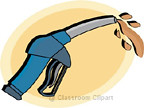In the past week, gasoline prices have risen to over $3 a gallon in many parts of the country. A few unfortunate spots have seen the price at the pump surpass $4 a gallon.
 That’s an increase of more than 40 percent in just a few months. Does that mean you should postpone that Route 66 vacation until gas prices fall? Does that mean you should cancel that road trip to find all the real-life inspirations you saw in the “Cars” movie?
That’s an increase of more than 40 percent in just a few months. Does that mean you should postpone that Route 66 vacation until gas prices fall? Does that mean you should cancel that road trip to find all the real-life inspirations you saw in the “Cars” movie?
Of course not.
That’s because a Route 66 trip will be one of the most economical vacations you’ll ever take. Many of the motels listed on this site are much cheaper — and more interesting — than the chain motels you’ll find along the interstate. Most of the restaurants along the Mother Road won’t gouge you, either.
Simply put, Route 66 is a bargain.
To make that trip a bigger bargain, here are tried-and-true tips on how to maximize your gas mileage and save money at the pump. These tips have been confirmed by yours truly and the automotive experts like Edmunds.com.
Observe the speed limit. Fuel efficiency drops sharply when you speed. Fueleconomy.gov says it’s like paying additional 20 cents per gallon for each 5 mph you drive over 60.
Avoid jackrabbit starts. Peeling away from an intersection like Mario Andretti is an obvious waste of gas. But driving at a slower, steady pace in city traffic also makes it more likely you’ll hit the synchronized green lights.
Avoid too much idling. If you engine is going to run without moving for more than a minute, shut it off.
Travel light. An extra 100 pounds of luggage can reduce your mileage up to 2 percent.
Use cruise control. I was dubious how well this device worked, but Edmunds confirmed in testing that it can save up to 14 percent on fuel consumption.
If it’s hot, keep the windows up and use air-conditioning. Sure, the A/C makes the engine work harder. But rolling down the windows at highway speeds creates enough aerodynamic drag that it’s a wash. Keep the windows up, run the A/C and drive comfortably.
Adjust your driving to hills. Accelerate when approaching a hill, not when you’re on it. Your additional momentum will allow you to burn less gas when going uphill.
Use overdrive. It’s amazing how this frequently gets overlooked, but it is a big gas-saver when it’s operating.
Don’t use a roof rack. Vacationers love them because they offer additional storage space. But they create more aerodynamic drag and can reduce mileage up to 5 percent.
Keep your tires properly inflated. This is commonly overlooked, but an underinflated tire can drop your mileage by up to 15 percent. The recommended pressure is on the sidewall of each tire. Keep a tire gauge in the glovebox to check them.
Make sure your air filter is clean. A dirty air filter can reduce mileage up to 10 percent. If it’s dirty, go to a parts store and buy a new one. It’s easy on most cars to replace it yourself.
Use the proper motor oil. If your owner’s manual recommends 5w30 oil, don’t put 10w40 oil in it. This makes the engine work harder.
Don’t buy gas near the interstate. It’s been my experience that stations near the off-ramps charge more for gas. Since you’ll be on Route 66 most of the time, this won’t be much of a problem . But if you have to travel on the superslab, check the price at stations farther away from the hubbub. You might find a cheaper fill-up.
Rent an economy car. European and Asian travelers might be tempted to rent a big Detroit monster or a sports car when traveling the Mother Road. Unless you have money to burn, don’t do it. Rent a fuel-economy car instead. Rates on these type of vehicles usually are cheaper, and you’ll consume less gasoline, too.
Happy driving.
Why is it that every time gas prices go up oil companies make huge profits. I think we are all being ripped off by the oil companies.
Supply and demand, John. Demand is much higher in the summer months; additionally, there is now a much greater demand for oil worldwide (esp. in China) than there was even five years ago. Furthermore, the little boutique summertime gasolines mandated by the federal government mean the refineries must all shut down, clean the pipes, and switch to refining the new stuff; that means a lower supply at the same time demand is beginning to rise.
As far as ‘huge profits’, not so much. Oil companies invest billions upon billions of dollars into research, exploration, drilling, refining, etc., so it is only natural that if you spend a ton of money on your business you’ll get a return that, in dollar amounts, looks extremely high. However, oil companies only make a 1-5% profit. Starbucks, on the other hand, or your local dairy, make double-digit profits, often as much as 30%.
I do not live in the US ( I am a Scouser living in Wales) so I maybe looking at this from a European perspective. In Britain gas prices went to nearly 5 pounds a gallon ( I think is around $8) over a year ago then shortly after one of the big oil companies boasted huge profits. A few years ago over here there were huge fuel protests from truck drivers and farmers who were not happy with fuel costs because it was threatening the future of their businesses.